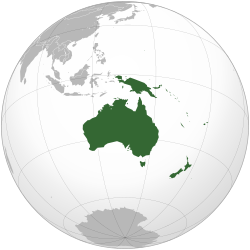Top Qs
Timeline
Chat
Perspective
Demographics of Oceania
From Wikipedia, the free encyclopedia
Remove ads
Oceania is a region centered on the islands of the tropical Pacific Ocean.[1] Conceptions of what constitutes Oceania vary, with it being defined in various ways, often geopolitically or geographically. In the geopolitical conception used by the United Nations, International Olympic Committee, and many atlases, the Oceanic region includes Australia and the nations of the Pacific from Papua New Guinea east, but not the Malay Archipelago or Indonesian New Guinea.[2][3][4] The term is sometimes used more specifically to denote Australasia as a geographic continent,[5][6] or biogeographically as a synonym for either the Australasian realm (Wallacea and Australasia) or the Oceanian realm (Melanesia, Polynesia, and Micronesia apart either from New Zealand[7] or from mainland New Guinea[8]).
Although Christmas Island and the Cocos (Keeling) Islands belong to the Commonwealth of Australia and are inhabited, they are nearer Indonesia than the Australian mainland, and are commonly associated with Asia instead of Oceania.
Remove ads
Demographics by territory
Summarize
Perspective
The demographic table below shows all inhabited states and territories of Oceania. The information in this chart comes from the CIA World Factbook[9] or the United States Department of State[10][m], unless noted otherwise or not available (NA); where sources differ, references are included.
Remove ads
See also
Notes
Summarize
Perspective
^ a: Papua New Guinea has over 860 non-official languages, comprising approximately ten percent of all languages on Earth.[29]
^ b: Melanesian pidgin is lingua franca in much of the country, but English remains the official language.[30]
^ c: Samoan and English were declared the official languages of American Samoa in June, 2010, via a constitutional amendment to the 1967 Revised Constitution of American Samoa.[21]
^ d: Palaun is the official language in all islands except Sonsoral (Sonsoralese and English are official), Tobi (Tobi and English are official), and Angaur (Angaur, Japanese, and English are official).
^ e: Based on a 1969 estimate.
^ f: English, while not an official language, is widely understood, spoken, and used for most government and commercial purposes.[31]
^ g: Norfuk was made the second official language of Norfolk Island in 2005.[32]
^ h: While no valid literacy data is available, Norfolk Island is assumed to have an adult literacy rate roughly at a par with Australia's literacy rate of 99%.[33]
^ i: On Atafu, all Congregational Christian Church of Samoa; on Nukunonu, all Roman Catholic; on Fakaofo, both denominations, with the Congregational Christian Church predominant.
^ j: While no valid literacy data is available, Niue is assumed to have an adult literacy rate of almost 100%.[34]
^ k: The Foreign and Commonwealth Office does not hold any statistical information on the literacy rate of the Pitcairn population.[35]
^ l: The residents of the Pitcairn Islands are descendants of HMS Bounty mutineers[36] and their Tahitian wives.
^ m: Much of the information on these two websites is taken from the censuses of other countries, and are not based on independent US government research. The remaining figures are based on estimates, and have been used only where census information from the nation in question is incomplete, unclear, or nonexistent.
Remove ads
References
Wikiwand - on
Seamless Wikipedia browsing. On steroids.
Remove ads


